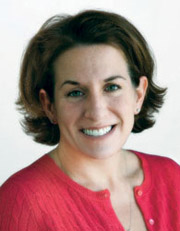Connecticut’s Welcome Woman
Karen Ross Senich, BA ’90, says she has one of the best jobs in Connecticut. As executive director of the Connecticut Commission on Culture & Tourism, she spends her days making her home state “a great place to live.”

From her office in Hartford, she directs a staff of 45 full-time employees charged with overseeing Connecticut’s arts, tourism, historic preservation, and film industries. The multifaceted position is a perfect fit for Senich, who grew up in Waterbury.
“I love what we do,” she says. “We’re the agency that focuses solely on good things—like funding innovative projects, preserving historic sites, and enhancing Connecticut’s quality of life and economic vitality. It’s truly incredible what I get to work on every day.”
She’s quick to state that a job in the tourism and cultural realm was nowhere to be found on her original career blueprint. “Growing up, all I ever wanted to be was a lawyer,” says Senich, who majored in criminal justice and minored in American literature at GW. Her next stop was Tulane University School of Law, where she earned a law degree, followed by nine years in private practice. “The practice of law was not what I hoped it would be,” she shares. Shifting gears, she was hired by the commission as director of operations in 2006 and became acting executive director in January 2007. In February 2008, Connecticut Gov. Jodi Rell appointed Senich to the top job, citing her excellent management skills and her passion for preserving and promoting the state’s cultural and tourism assets.
Senich’s position is the outgrowth of Connecticut’s decision in 2003 to merge the arts, historic preservation, tourism, and film into one agency. “Every state should consider combining these four entities, because there are so many opportunities for collaboration and growth,” she states. “Art museums, for example, are about so much more than art. They are tourism attractions and often historic sites as well. We are able to help them view themselves on a much broader canvas.”
Her favorite part of the job is distributing grants to hundreds of tourism attractions, cultural, and historic organizations across the state, enabling them to expand their programs and make necessary capital improvements. “We’ve helped fund some great projects, which is always very satisfying,” she says.
Senich also enjoys promoting and overseeing the state’s $14 billion cultural and tourism industry, featuring a wide variety of historical, arts, entertainment, and natural attractions. Dating back to Colonial times, Connecticut is home to many historic sites, as well as 137 state parks, an expansive coastline, and popular attractions like Mystic Seaport and Aquarium, the Mark Twain House and Museum, the Harriett Beecher Stowe House, the oldest public art museum in the United States (the Wadsworth Atheneum), and one of the oldest amusement parks in the country (Quassy).
“This year, in response to rising gas prices, we assisted the governor in implementing the “Staycation” destination program, encouraging Connecticut residents to spend their vacation dollars at home by offering them incentives like reduced admission prices to attractions,” Senich says. “We’ve had a very favorable response to the promotion.”
The commission also markets the state as a location for filmmakers. “In 2006, the state legislature passed the most lucrative film tax credit in the country—a 30 percent credit for filmmakers and video production companies spending $50,000 or more in Connecticut,” Senich explains. The credit has pumped millions of dollars into the state’s economy, with top movies like “Indiana Jones and the Kingdom of the Crystal Skull” and “College Road Trip” choosing to film segments in Connecticut.
Historic preservation and the arts are booming enterprises in the state as well. “Our office administers tax credit programs for historic preservation and gives out restoration dollars,” Senich says. “Also, 1 percent of all state-funded construction projects is routed to us to commission artwork for the state, so we have incredible works of public art all over Connecticut. A permanent gallery in our office features the work of Connecticut artists who have received grants from us.”
Senich says you can’t put a price tag on the commission’s work. “We help make the state a better place to live,” she says. “On a personal note, I grew up here and returned 12 years ago and am still constantly seeing new places and learning new things about Connecticut. It’s an exciting job, where I hope to remain for a long time.”
—Jamie L. Freedman
